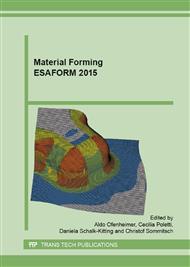p.89
p.96
p.102
p.108
p.114
p.120
p.126
p.132
p.138
High Strain Rate Behaviour of AA7075 Aluminum Alloy at Different Initial Temper States
Abstract:
The aim of this work is to study the mechanical properties of alloy AA7075 in both T6 and O temper states, in terms of visco-plastic and fracture behavior. Tension and compression tests were carried out starting from the quasi-static loading condition 10-3 up to strain rates as high as 2 x 103 s-1. The high strain rate tests were performed using a Split Hopkinson Tension-Compression Bar (SHTCB) apparatus. The tensile specimens were also subjected to micro-fractography analysis by Scanning Electronic Microscope (SEM) to evaluate the characteristics of the fracture. The results show a different behavior for the two temper states: AA7075-O showed a significant sensitivity to strain rate, with a ductile behavior and a fracture morphology characterized by coalescence of microvoids, whilst AA7075-T6 is generally characterized by a less ductile behaviour, both as elongation at break and as fracture morphology. Brittle cleavage is accentuated with increasing strain rate. The Johnson-Cook viscoplastic model wad also used to fit the experimental data with an optimum matching.
Info:
Periodical:
Pages:
114-119
Citation:
Online since:
July 2015
Keywords:
Price:
Сopyright:
© 2015 Trans Tech Publications Ltd. All Rights Reserved
Share:
Citation:


